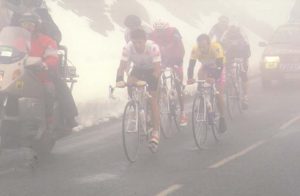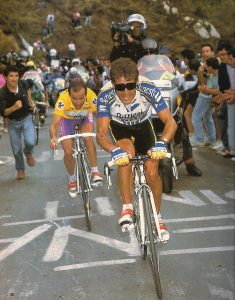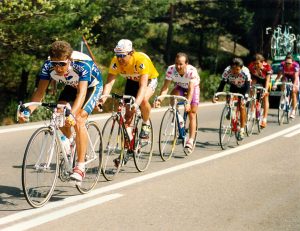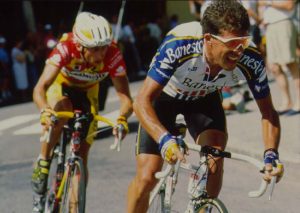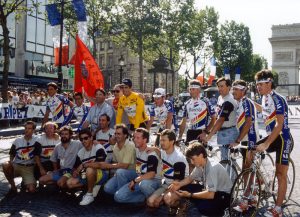1992 Banesto. Looking for the pedal stroke.
Banesto reserved Delgado as the only team leader for the Tour of Spain. «Riding at home is always an attraction and Miguel went to Italy to seek his fortune.»
The first week was quite relaxed and sprint finishes were the order of the day until they reached the first 50 km long individual time trial. An elated Montoya moved into yellow and Perico who was 8th in the time trial at 1’30», was only 1’41» behind.
The mountains made their appearance and before facing the Bonaigua mountain pass, there were rumours in the peloton that Tony Rominger would be dropping out because of knee problems. «I didn’t consider him my closest rival, but I wasn’t pleased about the news. He was one of my few ‘allies’ when it came to attacking the «Amayas» (with Montoya, Cubino and Parra)». The Swiss rider admitted to nearly dropping out but he remained in the race. Perico’s attack 3 km before the Alto de Beret finish succeeded and he managed to recover 30″ from the wearer of the yellow jersey. Thanks to this offensive, he frightened his rivals, who then raced against him. The next day, in French territory, on the way to Luz Ardiden and over the Tourmalet, the whole responsibility of the race laid with the Segovian. Cubino was in the break but got no collaboration from the other riders. Perico, tired of being watched so closely, decided to make a serious bet and let the race go free. He didn’t want to chase any more and let Rominger attack and move ahead near the finish in Luz Ardiden. Montoya, the leader, insisted on staying on Delgado’s wheel and then saw how the Swiss rider went ahead, robbing him of 1’03». «That day Montoya lost the Vuelta. His directeur sportif, Minguez, told him to keep to my wheel and forget about the others. It turned out to be a grave tactical mistake, as the time Rominger gained that day, was the time that eventually separated them at the end.».Amaya didn’t want Perico to surprise them and the only thing they achieved was to bring Rominger into contention.
The legendary Lagos stage saw the return of the Tour de France-like Pedro Delgado. At 5-km to the finish he attacked without looking back and scored a brilliant victory. The race was in the hands of three (Montoya, Rominger and Delgado). The Segovian tried again at 60-km to Avila but his rivals, shielded by their teams, managed to neutralise the break.
In the time trial of Fuenlabrada, Rominger showed he had everything that was needed to win a grand prix. He won it and was awarded the yellow jersey. Pedro Delgado was 3rd , behind Montoya and Rominger. «Even though I didn’t win, this was the Vuelta that I was most proud of».
After his success in the previous year’s Tour and his recent triumph in the Giro, it was a natural step for Miguel Induráin to take over the team leadership from Pedro Delgado. There was now a new generation, the generation of 1964, composed of Bugno, Alcalá, Breukink, Induráin, … who took the place of riders like Fignon, LeMond, Roche, Delgado, … from the generation of 1960. His experience in coordinating the team and in knowing what was «cooking» in the race, together with Miguel’s demonstration of power, not only in the San Sebastián prologue, but also in the individual time trial, did the rest. «When you start off a race with chances, you always calculate where you can gain time or where you can lose time. So when a man, like Miguel Induráin, showed enormous strength, as he did in Luxembourg, his most direct rivals needed a few days to assimilate their losses. For example, Bugno was 3rd at 3’41». On that day, I’m sure Bugno knew he had lost the Tour of France. I rode a great race. It was 65 km long and I only lost 4’52» and went up to 12th place in the general classification.»
In spite of having to work for Induráin, Pedro Delgado performed well in this, his 10th Tour of France. After having been first, second, third, fourth, …. he was once again 6th, like in 1985. It was a pity he didn’t succeed in winning the 12th stage which just wasn’t steep enough on the last climb.
